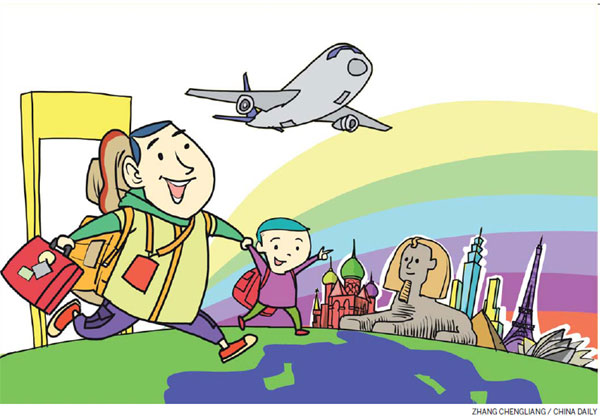World's treasured species: the Chinese tourist

Tourism operators are falling over themselves to win their attention, but deeper research into their needs is required
Despite the economic pall of gloom hanging over the planet, it seems that in the world of tourism the sun never quite sets.
A few weeks ago Taleb Rifai, head of the United Nations World Tourism Organization, painted a glowing picture of the industry, one in which revenue grew 4.5 percent last year. That money was dispensed by 1 billion people who traveled abroad, a rise of 4 percent on the year before.
Among them were 80 million Chinese tourists, a record. Just how steeply Chinese overseas travel has taken off is clear when you consider that in 2011 slightly more than 70 million Chinese made an overseas trek, and that the figure was 22.4 percent higher than in 2010.
It probably comes as little surprise then that the Chinese outbound tourism market has been the fastest growing one since the country opened the market in 1997.
Those who left China on overseas jaunts last year spent $91 billion (70 billion euros) while they were away, the UN tourism agency says, compared with $69 billion in 2011. The 2012 figure made Chinese the biggest-spending tourists after Germans, who spent $88 billion.
The most popular destinations in visitor numbers in recent years have been Hong Kong, Macao, South Korea, Taiwan, Malaysia, Japan, Thailand, the United States, Cambodia and Vietnam.
The willingness of Chinese overseas tourists to open their wallets has made them the darlings of the world's tourism operators in what might otherwise be very lean times.
In 2011, Chinese tourists spent 46,700 yuan ($7,510; 5,770 euros) per capita in Australia, 44,700 yuan in the US and 23,600 yuan in France, helping the tourism industry make hay while the sun barely shines.
With those kinds of figures it is little wonder that foreign tourism operators are beating a path to China to do deals with their counterparts. Little surprise, too, that one of the priorities of the foreign operators is to do everything they can to cater to the whims and wishes of Chinese customers, real and potential. Exactly how they can best do that is something many of these operators are trying to work out, to the extent that entire research departments are devoted to divining what makes the traveling Chinese consumer tick.
However, it would be wrong to see Chinese tourists as an easily identifiable, measurable group with common likes, dislikes and consumer demands.
For one thing, in a population of 1.3 billion, spending power is going to vary by function of province, county, city, town, village and, ultimately, the individual, so trying to come up with a meaningful Mr or Mrs Average is next to impossible. Some will be on the lookout for whatever is cheapest, while others will be looking for whatever is best. Some will cram visits to as many places as possible into as short a trip as possible, while others will do everything at a leisurely pace.
In that sense, in trying to understand the Chinese who head overseas on holiday and what they are looking for, a key idea to keep in mind is diversity.
Nevertheless, there will be a common strand to their demands.
Service in Chinese is one of them. Particularly in public areas they regard it as showing them respect, and they use it in gauging the quality of a destination. Chinese signs, Chinese TV channels, hot drinking water in hotels, tasty Chinese food are all aspects they care about. This is why shopping centers with Chinese-language guides and Union Pay services will always win their custom, and it explains why more than 20 percent of Chinese tourists choose to travel in groups when they travel abroad.
As the figures indicate, the most popular destinations for Chinese tourists are in Asia, but in recent years many have been venturing further south, to Australia and New Zealand, where they have become very popular.
In fact, the traveling times Chinese tourists choose now directly influence the peak and off seasons of foreign markets. China's golden weeks, winter and summer holidays have all become peak tourism seasons at those destinations.
In today's China, people born in the 1960s, 1970s and 1980s are potential customers for the tourism industry. In 10 to 30 years from now it will be today's teenagers who will be at the front of the line.
This generation will have enjoyed the fruits of prosperity and internationalization as children. They will then be ready for cultural and mental pursuits that their parents could only dream of.
If foreign destinations want to attract more Chinese tourists, and if the research departments mentioned above have any sense, they will be analyzing those teenagers now.
The author is the editor-in-chief of China Tourism News. The views do not necessarily reflect those of China Daily.
























